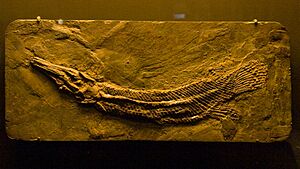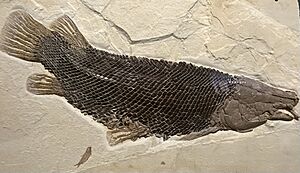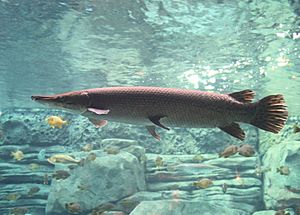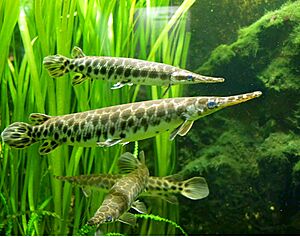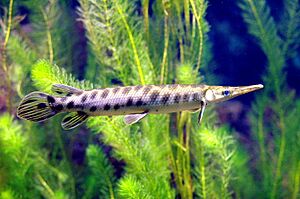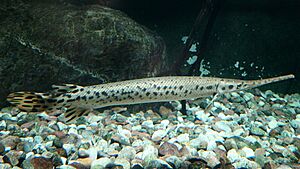Gar facts for kids
Quick facts for kids Gar |
|
|---|---|
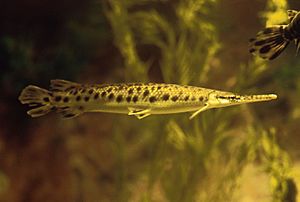 |
|
| Spotted gar (Lepisosteus oculatus) |
|
| Scientific classification |
|
| Kingdom: | Animalia |
| Phylum: | Chordata |
| Class: | Actinopterygii |
| Order: | Lepisosteiformes |
| Superfamily: | Lepisosteoidea |
| Family: | Lepisosteidae G. Cuvier, 1825 |
| Genera | |
|
|
Gars are an ancient group of fish. They are a type of ray-finned fish. There are seven living types, or species, of gars. They live in fresh, salty (brackish), and sometimes ocean waters. You can find them in eastern North America, Central America, and Cuba. Long ago, there were many more types of gars all over the world.
Gars are the only living members of a fish group called Ginglymodi. This group first appeared over 240 million years ago! Gars have long bodies covered in tough, armor-like scales called ganoid scales. They also have long jaws with sharp teeth. Sometimes people call them "garpike," but they are not related to pike fish.
All gars are quite large. The alligator gar (Atractosteus spatula) is the biggest. It can grow over 6.5 feet (2 meters) long and weigh more than 100 pounds (45 kg). Some have even been reported to be 10 feet (3 meters) long! Gars have special swim bladders that work like lungs. This means they can come to the surface to breathe air. Gar meat can be eaten, and their tough skin and scales are used by people. However, gar eggs are very poisonous and should never be eaten.
Contents
What's in a Name?
The name "gar" first came from an old English word for "spear." It was used for a different fish called a needlefish (Belone belone). This fish is now called "garfish" to avoid confusion.
The scientific name for gars, Lepisosteus, comes from Greek words. Lepis means "scale" and osteon means "bone." The name Atractosteus also comes from Greek, meaning "arrow."
Gar History and Evolution
Gars are the only living members of a group of bony fish called Ginglymodi. These fish were very common during the time of the dinosaurs, over 240 million years ago. Gars have changed very slowly over millions of years. Their closest living relatives are the bowfin fish.
The oldest known gar, Nhanulepisosteus, lived about 157 million years ago in Mexico. It lived in the ocean, which is different from most modern gars. This suggests that gars might have started in the ocean before moving into freshwater. Over time, gars spread to places like Africa, India, South America, and Europe.
Gars survived the big event that wiped out the dinosaurs. After that, they mostly lived in North America and Europe. Today, most gars are found in eastern North America.
Gar Family Tree
Scientists study the relationships between different types of gars. Here are two ways they think gars are related:
| Lepisosteoidea |
|
||||||||||||||||||||||||||||||||||||||||||
| Lepisosteoidea |
|
||||||||||||||||||||||||||||||||||||||||||
Where Gars Live
Long ago, gar fossils have been found on almost every continent. Today, living gars are only found in North America. They mostly live in the shallow, slightly salty (brackish) waters off Texas, Louisiana, and Mexico. They also live in some rivers and lakes that flow into these areas. Some gars are also found in the Great Lakes region of the United States.
How Gars Are Built
Gars have long bodies. They are covered in strong, armor-like scales. Their jaws are long and filled with sharp teeth. Their tails are shaped like a shark's tail, and their back fins are close to their tail.
Breathing with a Swim Bladder
Gars have a special organ called a swim bladder. It can work like a lung. This is why most gars come to the surface to gulp air. They do this more often when the water is warm or has low oxygen. Gars can live in water with no oxygen if they can breathe air. This special ability helps them survive in tough conditions.
Gar Size
All gars are big fish. The alligator gar is the largest. The biggest alligator gar ever recorded was 8 feet 5 inches (2.57 meters) long. It weighed 327 pounds (148 kg)! Even smaller types of gars, like the spotted gar, often grow over 2 feet (60 cm) long.
Gar Life and Habits
Gars usually move slowly. But they are very fast when they attack their prey. They like shallow, weedy parts of rivers, lakes, and bayous. They often gather in small groups. Gars are fierce hunters. They catch their prey with a quick sideways strike of their head. They eat smaller fish and creatures like crabs.
Most gars live in freshwater. But some types can live in salty (brackish) water. A few, like the Cuban gar, are even found in the sea sometimes.
Types of Gars
There are seven living types of gars in two main groups:
| Cladogram of living gars | |||||||||||||||||||||||||||||||||||||||
|
Here are the main types of gars:
- Genus Atractosteus
- Alligator gar (Atractosteus spatula)
- Cuban gar (Atractosteus tristoechus)
- Tropical gar (Atractosteus tropicus)
- Genus Lepisosteus
- Spotted gar (Lepisosteus oculatus)
- Longnose gar (Lepisosteus osseus)
- Shortnose gar (Lepisosteus platostomus)
- Florida gar (Lepisosteus platyrhincus)
Alligator Gar
The alligator gar is the biggest gar. It can be up to 10 feet (3 meters) long and weigh over 300 pounds (136 kg). It has a wide body and snout. People named it "alligator gar" because it looks a bit like an alligator. You can find them in Texas, Louisiana, and the Mississippi River. They like lakes and bays with slow water.
Alligator gars grow fast when they are young. They are usually deep green or yellow. People like to fish for them because they are so big. Their meat is also sold to eat. But too much fishing has made them almost disappear in some areas. Dams also hurt them by blocking their way to places where they lay eggs.
Some states now have rules to protect alligator gars. They have programs to bring them back to places where they used to live. For example, in Illinois, they release young gars that are big enough to survive. Some states limit how many gars you can catch. They also have rules about when and how you can catch them. Scientists have found that alligator gars help keep nature balanced. They eat fish like the invasive Asian carp.
Florida Gar
The Florida gar (Lepisosteus platyrhincus) lives in Florida and Georgia. It likes muddy or sandy areas with lots of plants. People often confuse it with the spotted gar. It has uneven black spots on its head, body, and fins. Its back is green-brown, and its belly is white or yellow. This coloring helps it hide and surprise its prey.
Female Florida gars are bigger than males. They can grow between 13 and 34 inches (33-86 cm) long.
Spotted Gar
The spotted gar (Lepisosteus oculatus) is a smaller gar. It is usually under 4 feet (1.2 meters) long and weighs about 15 pounds (6.8 kg). Like Florida gars, female spotted gars are usually larger than males. This gar has dark spots all over its head, body, and fins. It has a compact body and a shorter snout.
Spotted gars prefer clear, shallow water, about 10-16 feet (3-5 meters) deep. They like to hide among plants. They live in places like Lake Michigan, the Mississippi River System, and along the Gulf of Mexico coast. The alligator gar is their main predator. These smaller gars usually live for about 18 years.
Shortnose Gar
The shortnose gar (Lepisosteus platostomus) lives in the Mississippi River Basin. You can find it in states like Indiana, Wisconsin, and Louisiana. It likes lakes, swamps, and calm pools. It gets its name from its snout, which is shorter and wider than other gars. It has one row of teeth.
The shortnose gar is deep green or brown, like the alligator gar. It might have spots on its tail and back fins, depending on how clear the water is. It can live for 20 years. It grows to 24-35 inches (61-89 cm) long and weighs up to 5 pounds (2.3 kg). It eats more small creatures (invertebrates) than other gars. It also eats a lot of Asian carp.
Longnose Gar
The longnose gar (Lepisosteus osseus) has a long, narrow body. Its snout is more than twice as long as the rest of its head. This helps you tell it apart from other gars. It can grow up to 6 feet 8 inches (2 meters) long and weigh 35-80 pounds (16-36 kg). Like the shortnose gar, it has only one row of teeth.
Unlike some relatives, the longnose gar sometimes goes into salty (brackish) water. Female longnose gars are bigger and live longer than males. Females can live 22 years, while males live about half that long. They have spots on their head, back, and tail fins. Their color changes with the water. In clear water, they are dark green. In muddy water, they are more brown.
Longnose gars are found in a large area of North America. This includes Florida, Quebec, most of the Great Lakes, and down to northern Mexico.
Gar Eggs: A Warning
Gar meat is safe to eat. But their eggs, called roe, are very poisonous to humans. They contain a protein toxin. Even if you cook the eggs, they usually don't get hot enough to destroy the toxin. Eating gar eggs can make people very sick.
Scientists thought the toxin might protect the eggs from predators. But experiments showed that bluegill and channel catfish, which eat gar eggs, were not harmed. However, crayfish that ate the eggs did get sick and often died. So, the eggs being toxic to humans and crayfish might just be a coincidence.
Gars and People
Some types of gars are kept as aquarium fish. The hard, armor-like scales of gars are sometimes used to make jewelry. Their tough skin can be used to make things like lamp shades.
In the past, Native Americans used gar scales as arrowheads. People in the Caribbean used gar skin for chest armor. Early American pioneers even covered their plow blades with gar skin. Scientists are studying gars because they might have a very strong way to repair their DNA. If this is true, it could help in medical treatments for human diseases like cancer.
Not much is known about how gars fit into Native American religions. But some tribes, like the Creek and Chickasaw, performed special "garfish dances."


